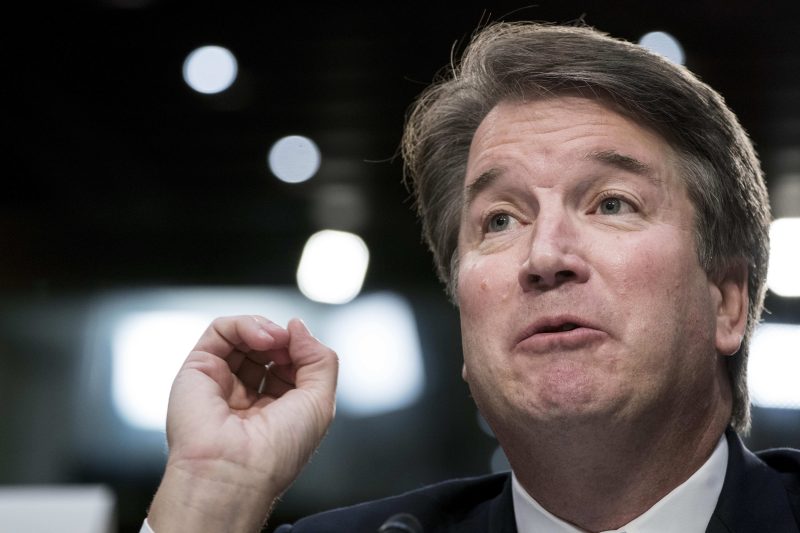A Texas judge’s order on Friday to suspend federal approval of the abortion pill, combined with a contradictory ruling in Washington state, has put the matter on course for a presumptive date with the Supreme Court.
At which point we might find out just how committed the justices — and specifically, Justice Brett M. Kavanaugh — are to staying out of the abortion issue after overturning Roe v. Wade.
When the Supreme Court overturned Roe in the summer, its conservative-leaning justices made a point of arguing repeatedly that their decision was merely putting the issue in the hands of elected officials. They cast past courts, which had established a constitutional right to an abortion, as overreaching, and they said these things were best left to the will of the voters.
Perhaps most significant was Kavanaugh’s concurrence. That’s both because it sought to blunt criticism of the decision and because he provided a crucial vote in the 5-4 split to overturn Roe. That appeared to set Kavanaugh up as a potential fulcrum of the court on abortion issues.
Kavanaugh suggested that the decision meant the court would effectively wash its hands of the issue moving forward. And that’s something critics of U.S. District Judge Matthew J. Kacsmaryk spotlighted soon after Kacsmaryk moved to suspend the Food and Drug Administration’s 2000 approval of mifepristone.
But it’s worth digesting the precise language Kavanaugh used.
“After today’s decision, the nine Members of this Court will no longer decide the basic legality of pre-viability abortion for all 330 million Americans,” Kavanaugh wrote in Dobbs v. Jackson. “That issue will be resolved by the people and their representatives in the democratic process in the States or Congress.”
While acknowledging how politically heated the abortion issue is, Kavanaugh wrote, “Especially in those difficult and fraught circumstances, the Court must scrupulously adhere to the Constitution’s neutral position on the issue of abortion.”
He added: “The Court today properly heeds the constitutional principle of judicial neutrality and returns the issue of abortion to the people and their elected representatives in the democratic process.”
Some have cast this as Kavanaugh offering assurance that he wouldn’t be a part of the court’s partaking in other, far-reaching abortion decisions. Kavanaugh certainly emphasizes neutrality while trying to sell the decision in what is a transparently political concurrence.
Given that medication appears to account for more than half of abortions in the United States — in addition to the fact that the abortion pill could be used in states that ban abortion — it’s difficult to think of a more consequential abortion-related issue for the post-Dobbs court to weigh in on. And that merits a closer look at Kavanaugh’s language, which reveals that he wasn’t at all clear that he was promising a hands-off approach in such situations.
Perhaps the key phrase in the above excerpts from Kavanaugh’s opinion is “basic legality.” Elsewhere in his concurrence, he seems to draw a line between that and the periods during which abortion could remain legal and other fundamental issues of the legality of abortion. And while he does so, he seems to separate that from other “abortion-related legal questions.”
“Other abortion-related legal questions may emerge in the future,” he wrote. “But this Court will no longer decide the fundamental question of whether abortion must be allowed throughout the United States through 6 weeks, or 12 weeks, or 15 weeks, or 24 weeks, or some other line. The Court will no longer decide how to evaluate the interests of the pregnant woman and the interests in protecting fetal life throughout pregnancy.”
Certainly, the Texas decision involves a prominent abortion method and would have huge ramifications if the Supreme Court were to sign off on it or anything like it. It might be the most consequential abortion-related issue the court could decide in the coming years.
But the flip side of that is that such a decision could be construed not as ruling on the “basic legality” of medication abortion, but as an administrative matter. While Kacsmaryk holds staunch antiabortion views and layered his opinion with such rhetoric — for example, writing “unborn human” and “unborn child” rather than “fetus,” and “abortionist” rather than “doctor” — his central holding is that the FDA erred in determining that mifepristone is safe and that it disregarded arguments to the contrary.
More than 100 studies have found the pills to be safe and effective, according to a New York Times review. And it’s not at all clear that the Supreme Court would sign off on something as severe as the Texas ruling. But it’s not as though Kavanaugh said the court would stay out of all abortion rights cases moving forward. And however well-constructed Kacsmaryk’s argument is, it’s not difficult to see Kavanaugh and others casting it as an “abortion-related legal question” rather than a question about the “basic legality” of abortion.
The situation is something of a callback to when Roe was overturned. At the time, critics of the decision pointed to comments Kavanaugh and other conservative justices made at their confirmation hearings, while suggesting they had gone back on promises to uphold Roe. In fact, each of the justices had offered responses on the subject that were obviously carefully worded and kept the door ajar, as we and others noted even during those hearings.
But perhaps the one overturning justice who went the furthest to allay concerns that he had such a goal in his sights? Brett M. Kavanaugh. He needed a vote from a Republican senator who supported abortion rights. He repeatedly described Roe as “precedent on precedent” and “settled as precedent,” and he said a majority of justices disagreeing with a precedent should not be sufficient to overturn it.
By 2021, he had altered his tone significantly. And by 2022, he voted with a bare majority of justices to overturn Roe.

